Dresden is a city I love, I lived there for 11 months while I was in Erasmus. When I decided to move to Dresden I didn’t even had a clue about the city. I simply wanted to live in Germany, without any city in mind. The only research I did before moving there was to check for city maps. I was amazed by what I first saw, a gorgeous city!
A lot changed in the last decade, and when it was the 10th anniversary since I lived there, I decided to go back and visit the city and the surroundings from another point of view. I wasn’t a student anymore, my mindset also changed, I visited it as a tourist, and of course, the city also changed a lot. But there are certain things that are eternal (or they should be), which turns this article into evergreen.
What to visit in the city of Dresden
One of the best perks of living in a city in Germany is the public transportation. You can visit a lot of the surroundings of a city just by using public transportation. Thanks to the big university, Dresden has even better connections (I guess). Therefore I will split this article in two main parts. What to visit in the city and what to visit in the surroundings.
Frauenkirche (Our Lady Church)
This is one of the most emblematic sites in the city. It is also a building that doesn’t seem to fit. All the surrounding buildings are quite darker and older, while the Frauenkirche is there in the middle, really white and looking quite new. But why? And why is it considered one of the most emblematic sites in the city?

In fact, it is a new building. With less than 40 years. And it is also a fact that all the buildings surrounding it are between 2 and 3 century years old (maybe even more). The original building was destroyed during World War II, and the remains were kept as a memory to the cathedral that used to be there. With the merge of both Germanys, they decided to rebuild the cathedral using, as much as possible, the original materials. With the exception of the dome, and with the help of technology, they rebuilt the cathedral that we can visit today.
It isn’t just a gorgeous monument to visit, but also a site filled with history and symbology for the local population. One should visit it both from outside and inside!
Fürstenzug (Procession of Princes)
Quite near the Frauenkirche there is a pane of tiles that won’t go unnoticed to those who pass in that street. It is called the Procession of Princes, and it displays all the Saxony prices between 1127 to 1904, with the exception of the first and the last princes. I don’t know the reasons for the exclusion of the first one, but the last one wasn’t excluded, the pane was simply created before he became king of Saxony. The pane also displays several scientists, artists, children and farmers.
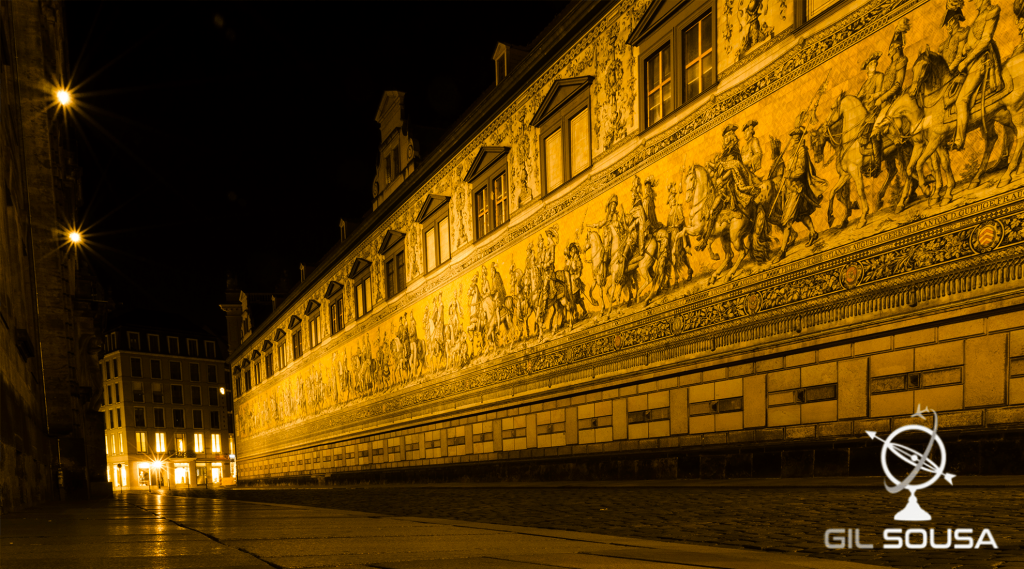
This pane was initially a painting, but quickly it started to deteriorate, so they replaced it by a pane of tiles from Meißen. They were hardly damaged with the World War II bombing, so the pane we can see today is still the original one.
Hofkirche (Cathedral of Dresden)
The historical cores are one of the biggest advantages of older cities. In German they name the old town as “Altstadt”, which means literally “old town”. The majority of points of interest are centered in these areas, so it gets fairly easy to visit several monuments in just one morning without hopping any kind of transportation.
The Hofkirche is one of the city’s most important monuments, the Cathedral of Dresden. While the Frauenkirche is a big church, the Hofkirche was raised as cathedral in 1964. Being considered as the city’s most important site of cult.
The best view for the cathedral is really from the other side of the river, where you can take the classic photo of Dresden old town (Altstadt). And of course, from near and from inside it is also quite impressive!
The Brühl Terrace
One of the singular characteristics of this site that impressed me the most unfortunately is not in place anymore. Until 2013 it was possible to listen to the Dresden bombings from the Brühl Terrace. You just had to place your elbows on the rail with a view over the Elbe, and with the hands touching your ears you would hear the recording being propagated through the rail and your arms. It was a really interesting experience, unfortunately it is no permanently closed according to the article I found while researching for this one.
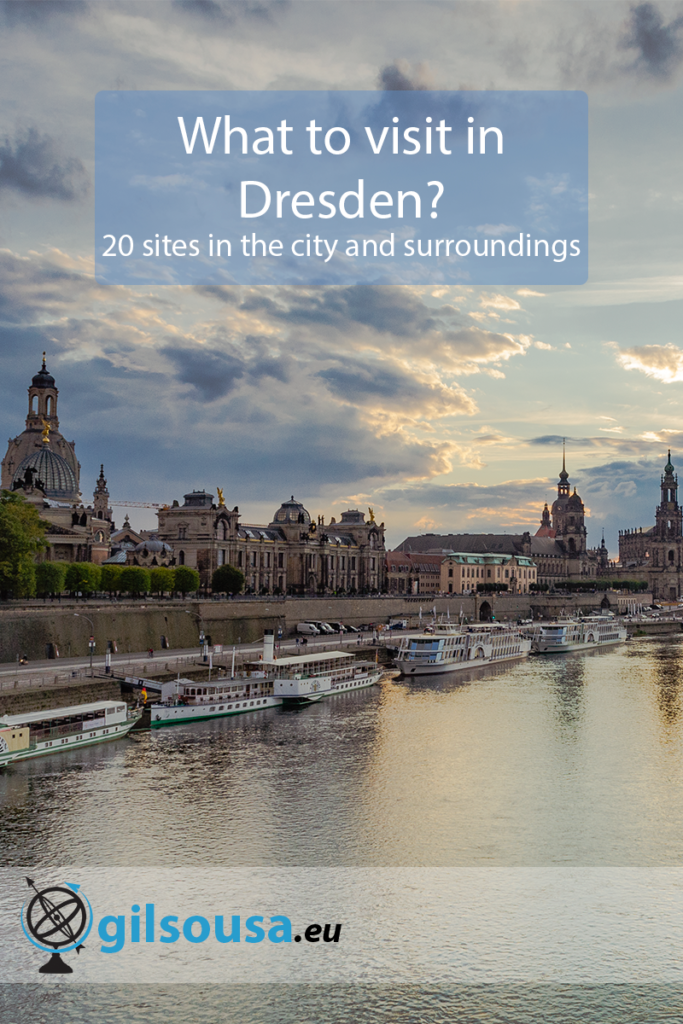
Regardless of that experience, this terrace is a really beautiful and quiet site, where occasionally they also have outdoor expositions. And the view? Always facing the Elbe Valley, towards the new side of Dresden. The perfect stop to rest your legs after a walk through the old town.
Albertinum
The Arbertinum is located at the Brühl Terrace, it is a museum or modern art which has two main galleries. The New Masters’ Gallery and the Collection of Scuptures.
It is a building that easily can go unnoticed, considering it is of the same architecture style as all the other buildings around it. But still, it is a beautiful building to see from outside.
From inside, it houses countless pieces of art, which is excellent for those who like to visit museums when visiting a new city. But is is also for those who like to see something different.
Both the bombings and the floods damaged this building. Even though it is quite elevated, it was still affected by the floods, so much that they had to create a new flood proof storage room.
Semperoper
The Semperoper building is another building filled with history, and it was rebuilt twice! The first time it was after a fire, and the second time exactly 40 years after being destroyed for the first time, during the last weeks of World War II.
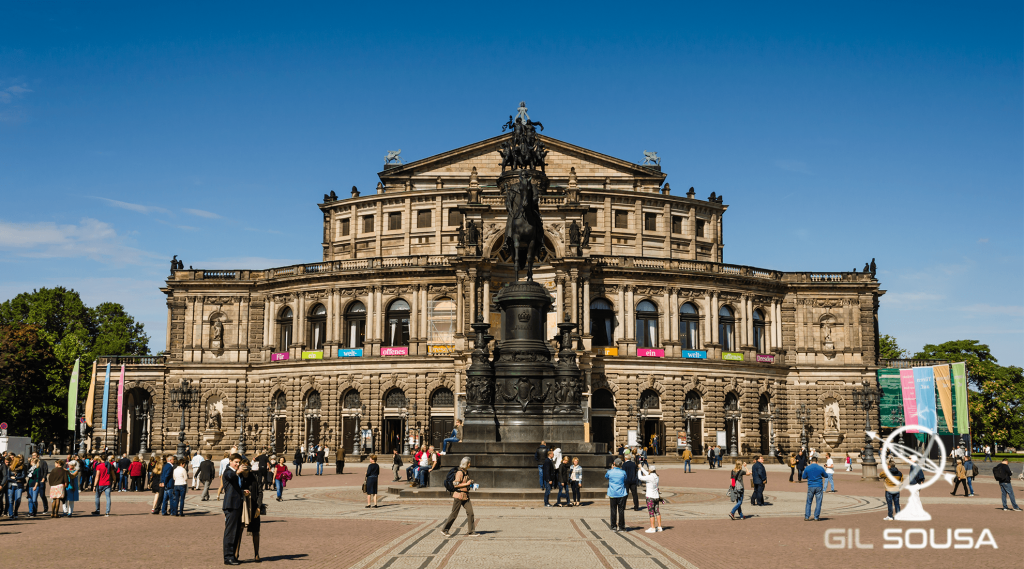
If it wasn’t obvious before, Dresden was heavily bombed during World War II, therefore some of the buildings in Altstadt are more recent than the ones in the newer side of the city.
The Semperoper was also place for the premier of several works of Richard Strauss during the years prior to the war. Nowadays it is one of the most beautiful buildings in Dresden, and also one of its icons.
Zwinger
Another site that changed with time, also because of Dresden’s bombing, but more recently also because of the 2002’s floods. It is easy to find images of these floods and the damage it did to the city of Dresden. More impressing is being there, and realizing how high the tide had to raise to reach that level!
Zwinger is the palace of Dresden, rebuilt in 1963 like it was before the war. The site where the palace is was part of the limits of the old fortress of Dresden. Part of the wall is still preserved in the castle.
Nowadays it is well-known by its gardens, but also by the several museums that are housed in its quarters. It is right next to the Semperoper, and all of these buildings are part of the complex of Dresden Altstadt.
Augustus’ Bridge
The last point of interest in the old part of Dresden, and another monument that was rebuilt several times. But none of them due to the bombings, at least that I am aware of.
In that site place there was a bridge since the 12th century, but sometime during half of the 17th century the king Augustus ordered to have a bridge of 12 arches to be built. But to allow the river traffic, at the beginning of the 19th century the current bridge was built with just 9 arches, but wider to also have more space for the traffic over the bridge. The materials used was also sandstone.
The bridge connects the old part of Dresden, Altstadt, to the new city, Neustadt. Where there are several other monuments to visit, of which I will list a few. Through that bridge also cross three tram lines. The city of Dresden is really well organized regarding the transportation.
Kunsthof Dresden (Arts Passage)
Now in the “new” side of the city, Neustadt, there is a passage quite interesting and unique, and somehow popular in the social networks. It is a set of courtyards with façades decorated with themes and quite distinct from each other. Being one of them really popular due to having tubes in the shape of brass instruments to collect the rain.
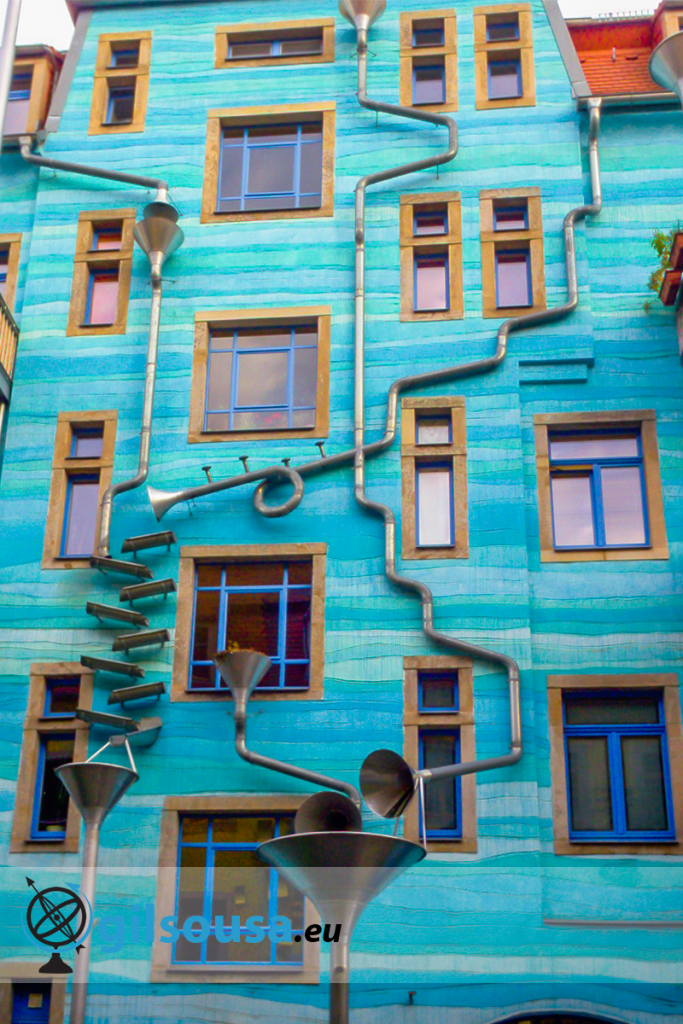
Unlike many people think, these “instruments” do not play any music when it rains. They are just a piece of decorative art, and the fewer sound you hear when it rains, is of the water hitting the metal. Acoustic does not work like that.
Finding this courtyard is a bit tricker, it is quite hidden. You need to pass through an entrance, that looks more like a private gate, to reach the yard between the buildings. But is is properly identified by a plate on the street side, if you see a sign with Kunsthof Passage, do yourself a favor and get in!
Gläserne Manufaktur (Transparent Factory)
The translation isn’t exactly accurate, it should be more like Glass Factory, however this translation would be out of context. The name comes from the fact that the factory is transparent, and you can see what’s going on inside from outside. It is a beautiful and impressive building.
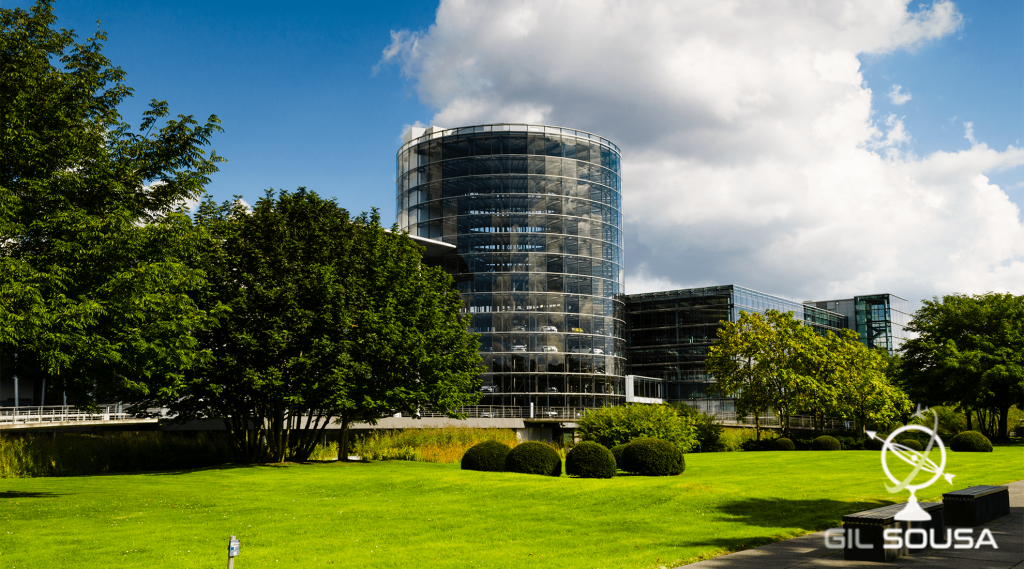
It is one of Volkswagen factories, and it is also an exhibitor of the brand. The guided tour is really interesting, you can see how the manufacture the cars almost everything by hand. This is one of the details that makes this factory unique, there is a lot of manual work and the employees wear white gown like if they were in a hospital. Everything is clean to the extreme, and that’s one of the factory’s brand image.
Most of those cars are made by pre-order, with specific guidelines by the new owners for certain parts of the car, for example, the boot. This means, that taking photos to some of the cars is strictly forbidden since they are already private property. But the experience is really interesting, for those who love cars, but also for those who are curious to see an unusual car factory.
Großer Garten (Big Garden)
There’s a lot to see in this garden, in fact, some of the things I thought about listing are all inside the Großer Garten, therefore I decided to merge it all here. You can spend a nice afternoon in the Großer Garten always with things to do.
Dresden’s Zoo is right next to the Großer Garten, the entrance is in one of the avenues next to the garden. But even from inside the garden you can see part of the Zoo.
If you don’t fancy walks, or you are with kids, there’s a really cool way to visit the Großer Garten, in a mini-train that crosses some areas of the park. With a few mini-stations that you can hop on and hop off, and explore some parts of the park without having to walk too much. But honestly? I prefer a nice walk and let myself get lost in the park!
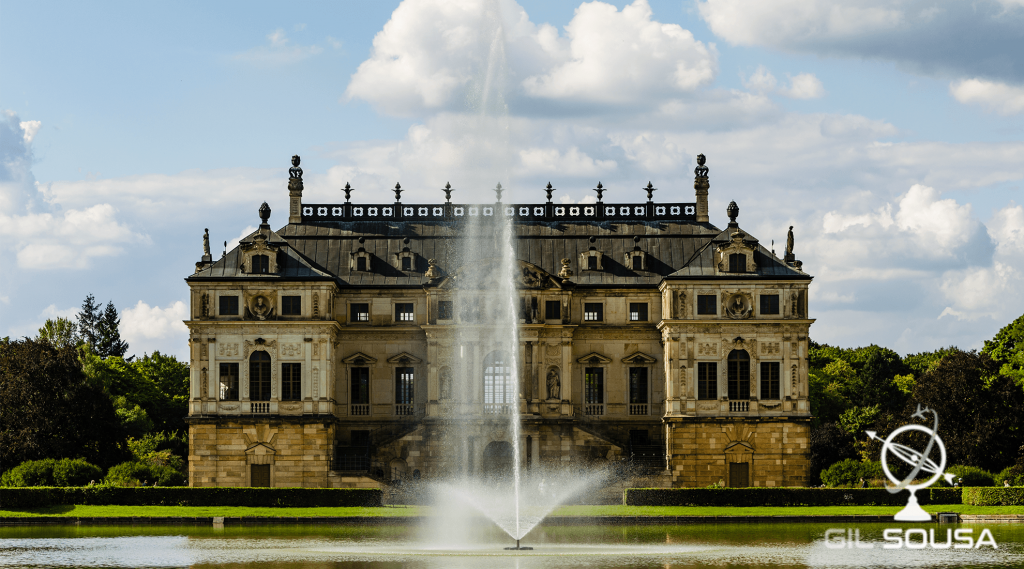
At the center of the Großer Garten there is a small palace with a lake at the back and a garden at the front. Really beautiful from outside, but honestly I never visited it from inside…
Also inside the park there is the Botanical Garden of Dresden, which makes a lot of sense considering this is the larges park/garden inside the city. In fact, the Großer Garten just by itself is a Botanical Garden, with a nice variety of trees and bushes, and several animals roaming through the park. You’ll see several squirrels, and some of them will even pose for photos…
While I wrote this article, I found out that the Transparent Factory is part of the Großer Garten. I thought it was simply by it, but apparently it is also part of the Garden! Here’s also this detail, if you plan to visit one of these two sites, the other one is right besides the other one!
German Hygiene Museum
This was one of the museums I visited while I was in Erasmus. Back then I only visited it because I found the name funny, but I wasn’t expecting to enjoy it as much as I did and to be surprised with what I saw in there.
The museum does not focus just in hygiene, in fact, the major focus is health in general and human’s science. One of the permanent expositions details the human race, the body, health, culture and social context of the human being. This exposition has the name of “Human Adventure”.
This museum is also targeted for children, with several activities through the whole museum. With focus for the Sensations Museum, which is really targeted to the younger generations. It is a museum for the whole family!
Blaues Wunder (Blue Wonder)
This is a century-old bridge, that connects two neighborhoods that back then were considered as some of the most expensive in Europe. The official name of this bridge has nothing to do with wonders nor with the blue color, id has the name of one of these neighborhoods, Loschwitz. It got the nickname Blue Wonder because back then it was considered as an engineering wonder, and also for its blue color.
This bridge can be found in the suburbs of Dresden, however there is a tram line that can take you almost to the bridge. Just a small walk from the tram terminal stop and you can enjoy this century-old bridge.
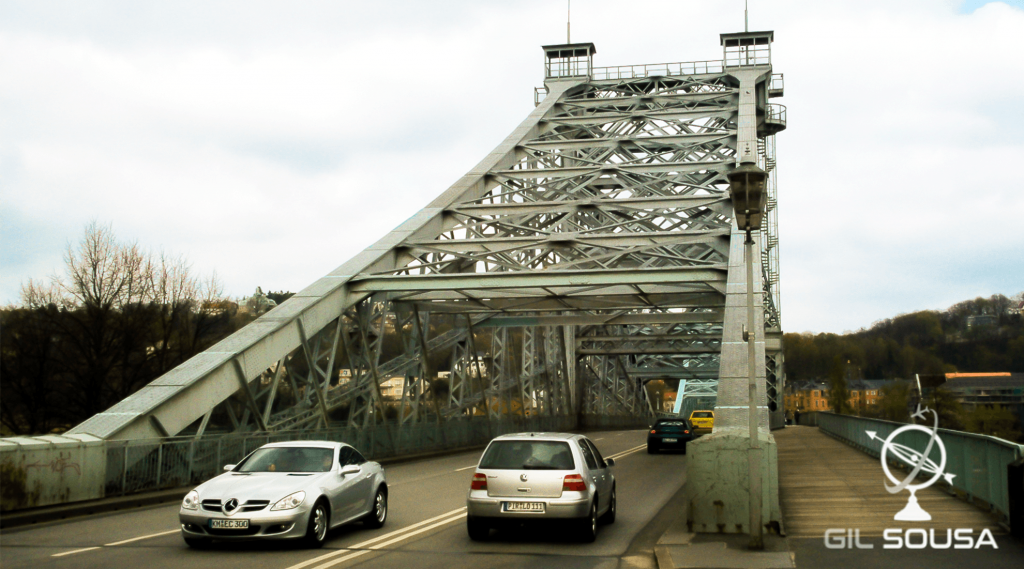
A small curiosity about this bridge, the area around this bridge was considered UNESCO Heritage for about 5 years, but it lost this recognition due to a bridge that was built right next to it. The new bridge was built with the intent of relieving the traffic crossing the Blaues Wunder, and to try to save it. Ironically, this new bridge led to UNESCO revoking the status of UNESCO Heritage.
During World War II this bridge was also in danger, but it was saved thanks to two people noticing the detonators installed by the SS and they cut their wires. Otherwise, this would be another one of Dresden’s monuments to be destroyed during the war.
Dresden’s Cablecar
Really close to the Blaues Wunder you can find one of the oldest cablecars in the world, it opened in 1901. Unlike almost all the other monuments listed previously, this one wasn’t damaged during World War II.
This cablecar works as a funicular. The car that goes down is connected by car to the car that goes up, using almost just gravity as a mechanical movement.
From this cablecar you can also visit another point of interest of the city (that I haven’t listed here), and that will give you a great view other the city and the Elbe Valley. The Television tower.
Another interesting option for those who like to walk, is to take the cablecar up and then walk down through one of the several trails that will lead you to the city. This option is cheaper if you want to save on the cablecar, and in my opinion also quite a rewarding experience.
What to visit in the surroundings of Dresden
Like I mentioned before, public transportation in Germany works really well, and it would be a shame not to visit some incredible places just by the fact that they are not inside a city. A lot of people travel to cities and they forget that there is much more to visit in the surroundings, and sometimes the surroundings are way better than the city itself. Not the case of Dresden, in my very biased opinion. the city is amazing! But so are the surroundings, hence me suggesting at least 5 days to visit the area, or maybe even a full week?
Pillnitz
Starting by the closest site to the center of Dresden, and in fact this site probably it would make more sense to be in the list above. However, I think it is already considered as being outside Dresden, even though, it is really easy to get there just by taking a tram and a ferry to cross the Elbe.
Pillnitz is a palace by the Elbe, with an incredible view over the valley. Incredible view but also intense, from one of the walls of the palace (the side of the river) you can see the marks of the floods that affected that area. Seeing how high the water reached in 2002, and then looking around and seeing that’s all just flat makes one thing! It is really scary to think that during 2002’s summer there was there a destructive sea.
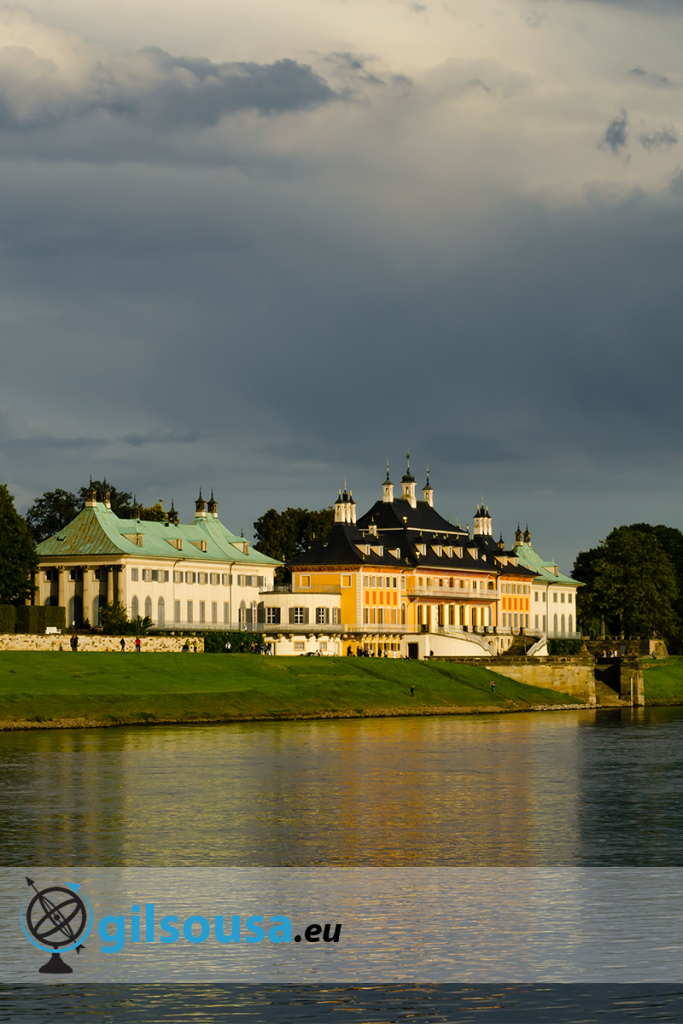
A trip to Pillnitz makes sense not just for the palace and the gardens, but also because one of the points of interest is the centenary Pillnitz Camellia, a 230 years old camellia. The importance of this tree goes unnoticed to visitors, even to some locals, this tree’s rarity is so important that in times it was used as a offering to strengthen political ties. It was offered three camellias, to Vienna, Hanover and Dresden. This was the only one that survived, hence the importance of protecting the tree.
Dresdner Heide (Dresden Heath)
Another place that it is basically part of Dresden city, but I decided to list it as the surroundings. The Dresdner Heide is a large forest in the city of Dresden with an area of 6133 hectares. It is an important recreative area for the city, because it is a vast area of nature and by its proximity to the city. In certain parts it is really close to the city center.
For the Nature lovers, this is the perfect escape for a bicycle trip right next to the city. The forest isn’t continuous, it has a few roads crossing it, and a main road that connects Dresden to the town of Radeberg, known by the beer brand of the same name. If you get too tired, you can always come back by train to the city center.
Moritzburg
I already mentioned this town in another article, it is well-known by the palace in the middle of a lake. The walk around the lake will give you plenty of opportunities for gorgeous views over the palace, with reflexions on the lake.
Moritzburg is a Baroque palace, built in the middle of the 16th century. Initially as a hunting lodge as the surrounding area was preferred by the Saxon royalty for hunting.
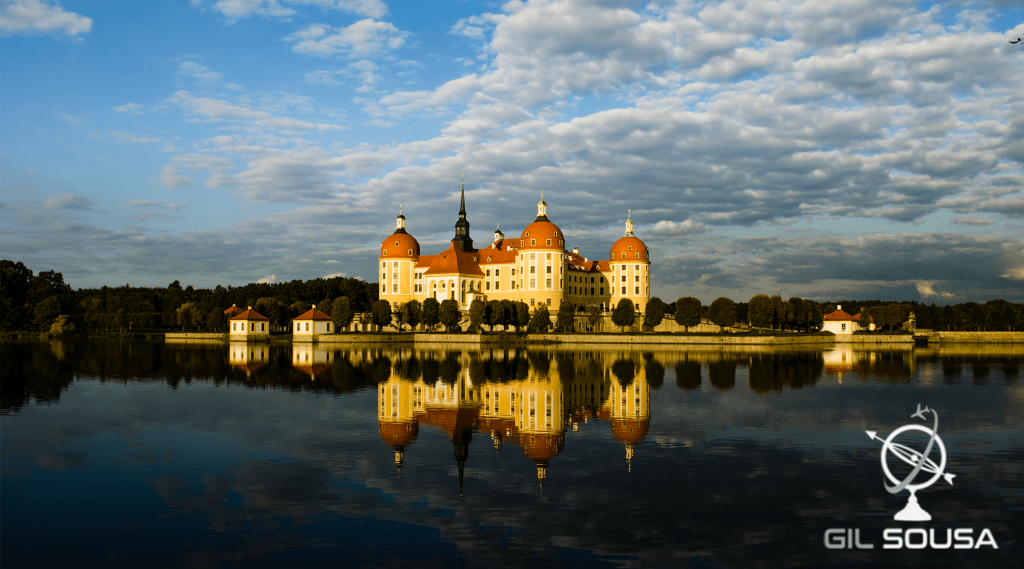
Nowadays the palace is one of the most visited sites in the area, and it lies just 13 km away from Dresden, being really easy to reach it by bus. It is often used for weddings and for other events. Finding the palace without people is almost impossible…
Elbe Valley
The Elbe Valley has a lot of things to see, so much that it even deserves an article for itself (and maybe I will write it)! So much that two of the places I listed below are in this valley.
One of the best known areas of the Elbe Valley is a National Park named Saxon Switzerland, of a stunning beauty! I also mentioned it in my other article, and it is one of my favorite places in Germany.
There are several ways to go through this valley, and the simplest is definitely by train, hopping off in any of the several stations along the river. Or, if you want to cross it by boat, you can take one of the several cruises that depart from Dresden. Regardless of your preferred way, it will be a memorable experience filled with photos.
Neurathen Castle
This is a really special castle, a kind of unique castle embedded in the rocks as a defense mechanism. Supposedly it is a type of medieval castle, however the first reference to this castle dates from 1755.
Nowadays there’s few left of the castle, only a few rooms carved in the rock, a cistern, the passages and not much more. But considering the view from up there, and the singularity of the castle, it is part of the recommended itinerary of Saxon Switzerland.
The Neurathen Castle is in the Elbe Valley, and it is one of the many sites that offer a stunning view over the valley.
Bastei
And following the Elbe Valley, really close to the Neurathen Castle. In facto, so close that basically they are part of the same complex. Bastei is a gorgeous bridge in the middle of the rocks with an elevation of almost 200 meters! Needless to say that the view from up there is stunning, with several opportunities for “almost” aerial photography over the Elbe Valley.
At first it was a wooden bridge, but due to the big amount of tourists that go there for the past 200 years, in 1851 the bridge was replaced by the actual bridge made out of sandstone.
Bastei is one of the best-known viewpoints of Elbe Valley. To get there you just need to take the train to Neurathen, cross the river by ferry, and walk to the top. Be ready for some steep walking though.
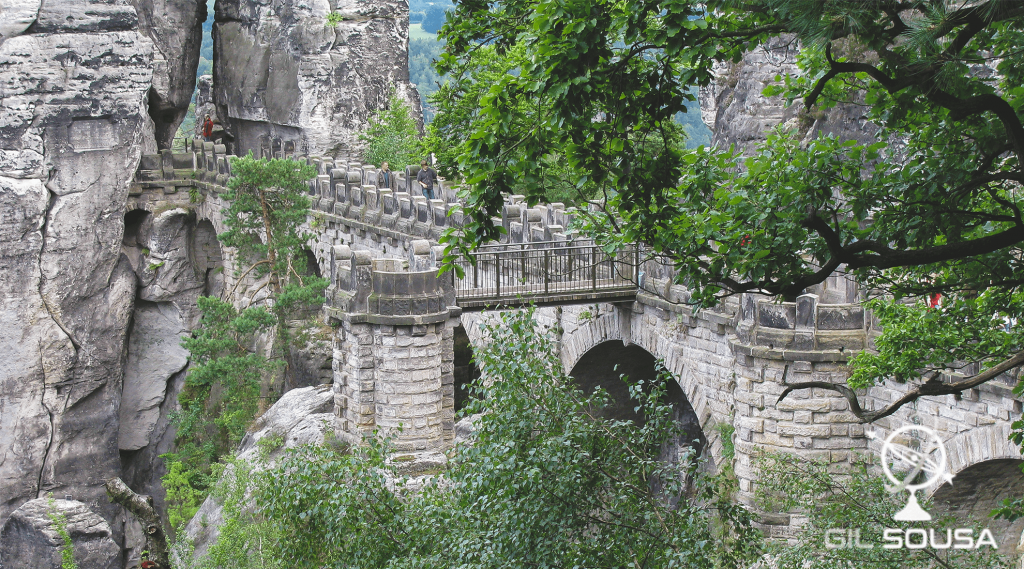
Besides these 20 places to visit in Dresden and surroundings, there are many other places worth a visit. Not just in the city, but also in the Elbe Valley. Unfortunately, or fortunately, Dresden isn’t so touristic as its neighbor Prague. Many tourists travel from Berlin to Prague by train, passing in Dresden without even stopping. Only then they regret when they see the view from the window of the train.
Dresden is a city that deserves an exclusive visit, not just for a weekend but for a full week. It is breathing a mix of old, recent and recreated history. When you considering about visiting Germany, don’t forget to include Dresden in your plans!



Leave a Reply